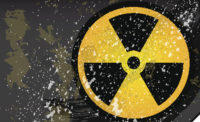Radiation detectors protect public health
“Dirty bomb” alerts raised by personal & passive devices

The symbol for radioactivity is universally known and helps create awareness and safety about radioactive situations
First responders, Homeland Security officers and others whose jobs involve safeguarding the public are increasingly arming themselves with radiation detection devices that can help them deal with hazardous materials events or acts of terrorism. Protecting their own safety as well as the safety of the citizens they serve depends upon their supervisors choosing the type of detection equipment that is appropriate for the likely scenarios they will face and on making sure that the people on the front lines know how to use it correctly.
A robust program
New York City, understandably, has developed a robust radiation detection system which includes both personal radiation detectors that officers carry with them while on duty and a system of passive detection that covers city streets, tunnels and waterways. The personal devices are about the size of pagers and produce a humming noise when radiation levels above normal are detected. The passive systems includes cars placed around the city with radiation detectors hidden in them as well as a counterterrorism boat with a radiation detector built right into its hull — a complex and connected network intended to alert authorities to the presence of “dirty bombs” — which combine conventional explosives like dynamite with radioactive materials — before they can be detonated.
The detectors in use are capable of detecting even minute amounts of radiation. Fortunately, many of the “hits” that register are for legitimate instances of radiation, such as with a patient who has recently had radioiodine treatment for a thyroid condition, or some other low-mass radioactive element used in nuclear medicine.1
Event protection
Beyond day-to-day security, special events which draw large crowds have also come to require the deployment of radiation detection devices. During last year’s Independence Day celebrations, detectors were in heavy use around Washington, D.C., carried by Massachusetts state police on duty in Boston and manned by National Guard units all around the country.2
Training is critical
Training personnel in the use of detectors is vital in security efforts. The Boston Fire Department’s special operations unit recently held an event at which they showed first responders from several nearby communities how to use the latest radiation detection equipment.3
In Cleburne, Texas radiation detectors were a key part of a mock drill held this year for first responders. The event was designed to prepare them in case there is ever an explosion at the Comanche Peak Nuclear Plant which is about 30 miles west of the city.
Participants wearing hazardous material suits wore dosimeters on the outside of their suits to record any radiological doses they might receive while performing their duties, which included using detectors to determine if the “evacuees” being brought to the staging area had been contaminated with radiation. Contaminated evacuees were directed to a separate area where they showered and were given clean clothes – then monitored again to determine if the decontamination efforts had been successful.4
Radiation is a form of energy that occurs both naturally, in sunlight, and in man-made forms used in X-rays, nuclear power plants and cancer treatments. Exposure to large doses of radiation can be fatal and can cause immediate radiation sickness as well as delayed illnesses like cancer.
Looking for a reprint of this article?
From high-res PDFs to custom plaques, order your copy today!







